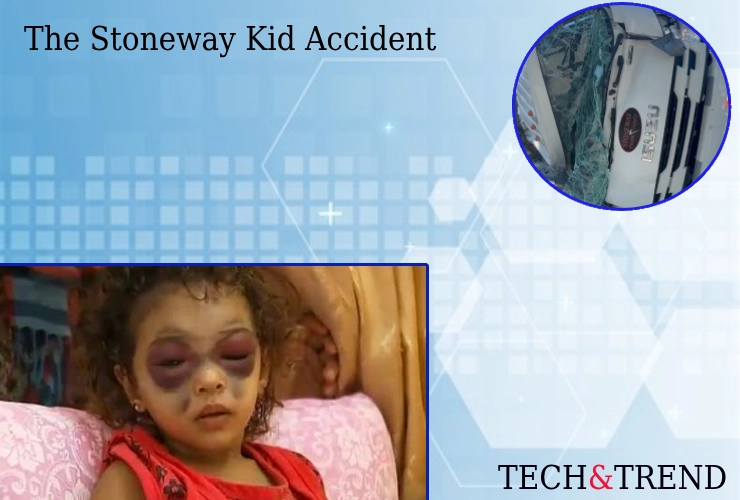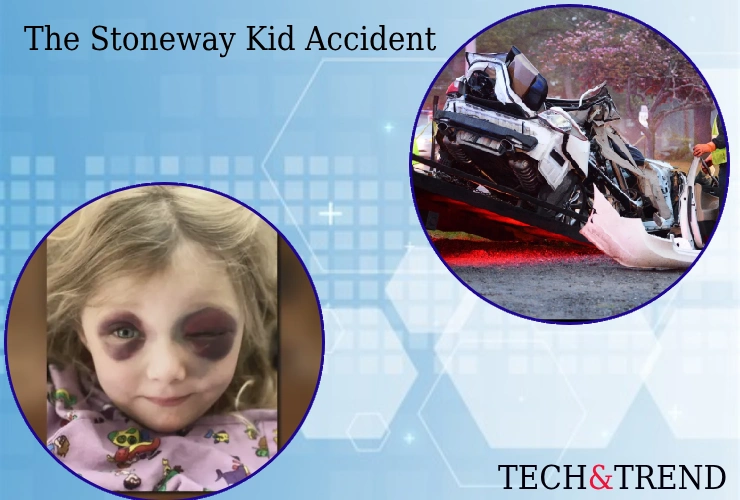Accidents can happen at any moment, and they often leave a lasting impact on young lives. The Stoneway Kid Accident, though not specifically detailed in recent news, serves as a reminder of the importance of safety and awareness. This article will explore lessons learned from tragic incidents, safety measures every kid should know, and how communities can support accident victims. It will also discuss the role of awareness campaigns in reducing accidents and the journey from tragedy to advocacy.
Lessons Learned from Tragic Incidents
Tragic incidents like the recent wrong-way crash on Long Island, where a 9-year-old boy lost his life due to his mother’s actions, highlight the need for vigilance and responsible behavior. Such events remind us that accidents can occur unexpectedly and often have devastating consequences. In this case, the driver was under the influence and failed to stop for a traffic stop, leading to a fatal head-on collision. These incidents teach us about the importance of adhering to traffic laws and the dangers of substance abuse while driving.
Key Takeaways:
- Responsible Driving: Always drive sober and follow traffic rules to prevent accidents.
- Vigilance: Be aware of your surroundings, especially on the road.
- Emergency Preparedness: Know what to do in case of an emergency, such as calling for help or performing basic first aid.
Safety Measures Every Kid Should Know
Children should be taught basic safety measures to protect themselves in various situations. Here are some essential safety tips for kids:
Road Safety
- Always Wear a Seatbelt: Whether you’re in the front or back seat, wearing a seatbelt can save your life.
- Stay on the Sidewalk: When walking, stay on the sidewalk and avoid walking on the road unless it’s absolutely necessary.
- Look Both Ways: Before crossing the street, always look left, right, and left again for oncoming vehicles.
Home Safety
- Fire Safety: Know how to stop, drop, and roll if your clothes catch fire. Also, know the escape route from your home in case of a fire.
- Electrical Safety: Avoid playing with electrical appliances or cords.
- Poison Control: Know the number for poison control and never touch unknown substances.
General Safety Tips
- Stay Close to Adults: In public places, always stay close to a trusted adult.
- Be Aware of Strangers: Never go anywhere with someone you don’t know.
- Emergency Numbers: Memorize important phone numbers like 911.
Understanding the Importance of Road Safety for Children
Road safety is crucial for children, as they are often more vulnerable to accidents due to their size and lack of experience. Here are some ways to ensure children stay safe on the roads:
Educating Children
- Teach children about traffic rules and signs.
- Encourage them to always use crosswalks and follow traffic signals.
- Practice safe walking and biking habits with them.
Parental Involvement
- Always supervise children when they are near roads.
- Ensure they wear appropriate safety gear, such as helmets when biking.
Set a good example by following traffic rules yourself.
Lessons Learned from The Stoneway Kid Accident: Enhancing Safety Measures
The Stoneway Kid Accident serves as a poignant reminder of the importance of safety measures in preventing tragic incidents. By understanding the circumstances surrounding such accidents, we can identify critical areas for improvement. This includes enhancing road safety, improving home safety, and promoting awareness campaigns that educate both children and adults about potential hazards. By learning from these incidents, we can work towards creating safer environments that protect young lives and foster a culture of safety within our communities.
A Parent’s Guide to Preventing Childhood Accidents
Preventing accidents requires a combination of education, supervision, and setting a good example. Here are some tips for parents:
Supervision
- Always keep an eye on children, especially in environments that could pose risks, such as near water or on the road.
- Ensure they understand and follow safety rules.
Safety Education
- Teach children about potential hazards and how to avoid them.
- Discuss emergency procedures, such as what to do in case of a fire or if they get lost.
Creating a Safe Environment
- Secure your home by installing safety gates, locking cabinets, and removing hazardous materials.
- Ensure playgrounds and outdoor areas are safe and well-maintained.
How Communities Can Support Accident Victims
Communities play a vital role in supporting families affected by accidents. Here are some ways communities can help:
Emotional Support
- Offer counseling services to help families cope with trauma.
- Organize community events to raise awareness and funds for affected families.
Practical Assistance
- Provide meals or other forms of practical support to families dealing with the aftermath of an accident.
- Help with fundraising for medical expenses or other needs.
Advocacy
- Advocate for better safety measures in the community, such as improved road conditions or increased safety patrols.
- Support legislation that enhances safety standards.
The Role of Awareness Campaigns in Reducing Accidents
Awareness campaigns are crucial in reducing accidents by educating the public about potential hazards and promoting safe behaviors. Here are some ways these campaigns can be effective:
Public Education
- Use media and public events to spread safety messages.
- Collaborate with schools to integrate safety education into curricula.
Community Engagement
- Engage community leaders and influencers to promote safety awareness.
- Organize workshops and seminars on safety topics.
Policy Advocacy
- Work with policymakers to implement safety regulations and laws.
- Support enforcement of existing safety laws.
Emotional Healing After Childhood Traumas
Children who experience traumatic events, such as accidents, may need support to heal emotionally. Here are some ways to help:
Professional Help
- Seek professional counseling or therapy to help children process their emotions.
- Encourage open communication about their feelings.
Supportive Environment
- Create a safe and supportive home environment where children feel comfortable expressing themselves.
- Engage in activities that promote relaxation and stress relief, such as art or play therapy.
Community Support
- Connect with other families who have experienced similar traumas for mutual support.
- Participate in community activities that promote healing and recovery.
Turning Tragedy into Advocacy: Stories That Inspire Change
Tragic events can serve as catalysts for change by inspiring advocacy efforts. Here are some ways individuals can turn tragedy into advocacy:
Raising Awareness
- Share personal stories to raise awareness about specific safety issues.
- Use social media and other platforms to spread safety messages.
Policy Change
- Work with policymakers to advocate for changes in safety laws or regulations.
- Support organizations that focus on safety advocacy.
Community Action
- Organize community events or campaigns to promote safety awareness.
- Collaborate with local leaders to implement safety initiatives.
Engaging Children in Safety Initiatives
Engaging children in safety initiatives can be both fun and educational. Here are some ideas:
- Safety Games and Quizzes: Develop games and quizzes that teach children about safety rules.
- Safety Clubs: Establish safety clubs in schools where children can learn and discuss safety topics.
- Community Events: Organize community events like safety fairs or parades to raise awareness and engage children.
The Power of Storytelling in Safety Education
Storytelling is a powerful tool in educating children about safety. Here’s how it can be effective:
- Relatable Characters: Use relatable characters in stories to make safety lessons more engaging.
- Real-Life Examples: Share real-life examples of accidents and how they were prevented to make the message more impactful.
- Interactive Sessions: Conduct interactive storytelling sessions where children can participate and ask questions.
Building a Safety-Conscious Community
Building a safety-conscious community requires collective effort. Here are some strategies:
- Collaborate with Schools: Work with schools to integrate safety education into the curriculum.
- Community Outreach: Conduct outreach programs to educate families about safety measures.
- Partnerships with Local Businesses: Partner with local businesses to support safety initiatives and provide resources.
Recent Tragic Incidents Highlighting Safety Concerns
Recent incidents have underscored the importance of safety measures. For instance, a tragic crash in Western Washington resulted in the loss of four children due to a driver who was significantly impaired, highlighting the dangers of driving under the influence[1]. Such incidents remind us of the need for vigilance and responsible behavior on the roads.
Conclusion
In conclusion, accidents like the Stoneway Kid Accident remind us of the importance of safety awareness and community support. By learning from tragic incidents, teaching children safety measures, and advocating for change, we can work towards creating safer environments for everyone.
Additional Strategies for Enhancing Child Safety
To further enhance child safety, consider these additional strategies:
- Use Technology Wisely: Utilize safety apps and devices that can help monitor children’s activities and locations.
- Community Engagement: Encourage community members to report any safety hazards they observe.
- Regular Safety Audits: Conduct regular safety audits in public spaces to identify and mitigate potential risks.
Creating a Culture of Safety
Creating a culture of safety involves making safety a part of daily life. Here are some ways to do this:
- Make Safety Fun: Incorporate safety into games and activities to make learning fun.
- Lead by Example: Adults should model safe behaviors to show children the importance of safety.
- Encourage Open Communication: Create an environment where children feel comfortable asking questions about safety.
By fostering a culture of safety, we can ensure that children grow up with a strong foundation in safety awareness, reducing the likelihood of accidents and promoting a healthier, safer community for all.
Empowering Children Through Safety Education
Empowering children with safety education not only protects them from harm but also builds their confidence and independence. Here are some ways to empower children:
- Teach Problem-Solving Skills: Encourage children to think critically about safety situations.
- Encourage Independence: Gradually give children more independence as they demonstrate an understanding of safety rules.
- Praise Safe Behaviors: Recognize and praise children when they exhibit safe behaviors.
By empowering children in this way, we help them develop into responsible and safety-conscious individuals who can navigate their environments safely and effectively.
The Future of Child Safety: Innovations and Trends
The future of child safety is evolving with innovations in technology and trends in safety education. Here are some exciting developments:
- Smart Home Devices: Smart home devices can help prevent accidents by alerting parents to potential hazards.
- Virtual Reality Safety Training: Virtual reality is being used to simulate safety scenarios, providing immersive learning experiences.
- Community Apps: Community apps are being developed to connect families with local safety resources and emergency services.
These innovations and trends hold great promise for enhancing child safety and creating safer communities worldwide.
Conclusion: A Safer Tomorrow for Children
As we look to the future, it is clear that creating a safer world for children requires a collective effort. By learning from past incidents, implementing safety measures, and engaging in community initiatives, we can build a safer tomorrow for all children. Let us work together to empower children with the knowledge and skills they need to thrive in a world that is both challenging and full of opportunities.
Additional Resources for Parents and Communities
For those interested in learning more about child safety and how to create a safer environment, here are some additional resources:
- National Safety Organizations: Many countries have national safety organizations that provide guidelines and resources for child safety.
- Online Safety Courses: There are numerous online courses and workshops available that teach safety skills to both children and adults.
- Community Safety Apps: Some communities have developed apps that provide safety tips and emergency contact information.
By leveraging these resources and engaging in safety initiatives, we can empower children with the knowledge they need to stay safe and thrive in their environments.


Comments are closed.